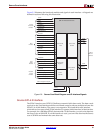
SPI-4.2 Lite v4.3 User Guide www.xilinx.com 39
UG181 June 27, 2008
Source Core Interfaces
R
Source Clocking Interface
The Source core supports two clocking implementations: master clocking and slave
clocking. The master clocking configuration provides a complete solution with the clock
circuitry embedded within the Source core. The slave clocking configuration allows the
clocking scheme to be implemented external to the Source core.
A list of the Source clocks for master clocking and their description is provided in
Table 2-16. Table 2-17 defines the Source Core clock status signals, and Table 2-18 defines
SrcCalendar_M[7:0] Input 0-255
(effective range 1-256)
Source Calendar Period: The SrcCalendar_M
parameter sets the number of repetitions of the calendar
sequence before the DIP-2 parity and framing words are
received.
The Source core implements this parameter as a static
register synchronous to SrcStatClk, and it can be
updated in circuit by first deasserting SrcEn.
Note that the Source Calendar Period equals
SrcCalendar_M + 1. For example, if SrcCalendar_M=22,
the Source Calendar Period will be equal to 23.
SrcCalendar_Len[8:0] Input 0-511
(effective range 1-512)
Source Calendar Length: The SrcCalendar_Len
parameter sets the length of the calendar sequence.
The Source core implements this parameter as a static
register synchronous to SrcStatClk, and it can be
updated in circuit by first deasserting SrcEn.
Note that the Source Calendar Length equals
SrcCalendar_Len + 1. For example, if
SrcCalendar_Len=15, the Source Calendar Length will
be equal to 16.
DataMaxT[15:0] Static Input 0, 16-65535 Maximum Data-Training Interval: Maximum interval
between scheduling of training sequences on the SPI-
4.2 data path (in SPI-4.2 bus cycles). Note that setting
DataMaxT to zero configures the core to never send
periodic training.
AlphaData[7:0] Static Input 0-255 Data Training Pattern Repetitions: Number of
repetitions of the 20-word data training pattern. Note
that setting AlphaData to zero configures the core to not
periodically send training patterns. In this case, you can
manually send training patterns by asserting the
TrainingRequest command.
NumDip2Errors[3:0] Static Input 1-15
Value equal to 0 gets set
to 1
Number of DIP-2 Errors: The Source Interface will go
out-of-frame (SrcOof asserted) and stop transmitting
SPI-4.2 data across the data bus after receiving
NumDip2Errors consecutive DIP-2 errors.
NumDip2Matches[3:0] Static Input 1-15
Value equal to 0 gets set
to 1
Number of DIP-2 Matches: The Source Interface
requires NumDip2Matches consecutive DIP-2 matches
before going in-frame and beginning to transfer SPI-4.2
data across the SPI-4.2 data bus.
Table 2-15: Source Static Configuration Signals (Continued)
Name Direction Range Description


















